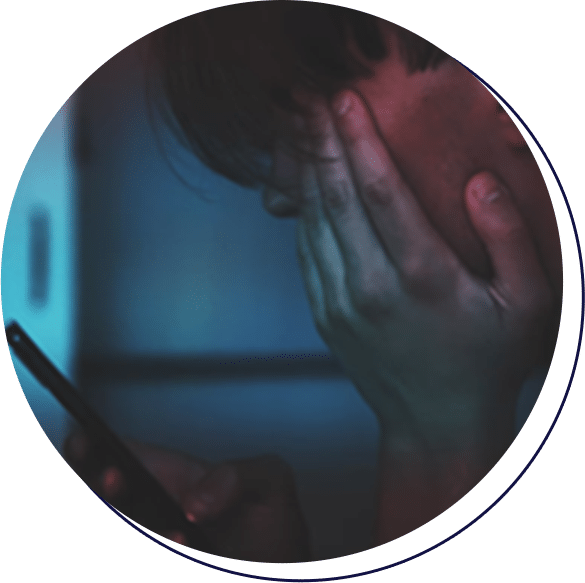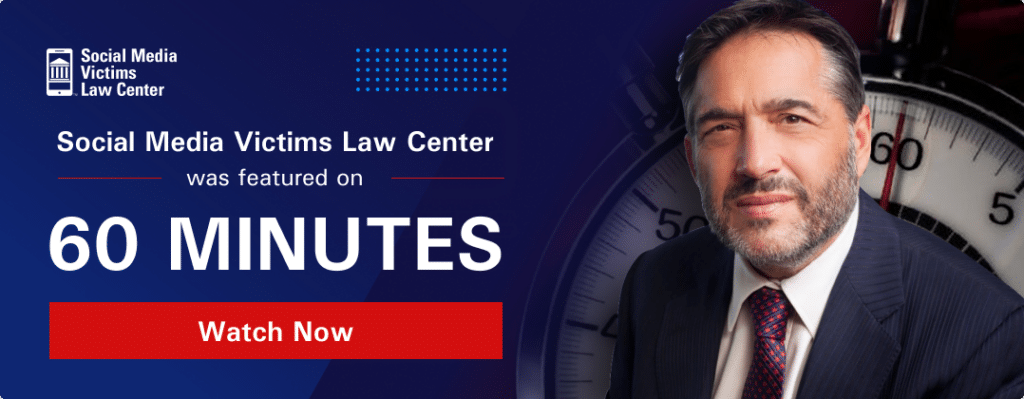Social Media & Suicide
Over the last ten years, there has been a significant rise in the risk of teenage suicide. Although several factors play a role in an individual’s choice to take their life, recent studies have established connections between mental health issues such as depression and suicidal ideation, and social media usage.
 Written and edited by our team of expert legal content writers and reviewed and approved by Attorney Matthew Bergman
Written and edited by our team of expert legal content writers and reviewed and approved by Attorney Matthew Bergman
- Content last updated on:
- February 26, 2024
Written and edited by our team of expert legal content writers and reviewed and approved by

- Content last updated on:
- February 26, 2024
According to the Centers for Disease Control and Prevention, nearly 46,000 people in the United States committed suicide in 2020 – that’s a rate of 14 people per 100,000. Among children and young adults ages 10 to 24, the suicide rate is 10.7 per 100,000 and is the second-leading cause of death.
It’s no surprise that teenage years are stressful. Regular developmental changes combined with other life events already can put boys and girls at risk for depression and suicide. In fact, the rate of teen suicide has risen dramatically over the past decade. At the same time, social media use has also risen among teens. Several studies have found a correlation between social media and suicide, and researchers have linked aspects of social media use to depression and higher suicide risk.
Overuse of social media poses a significant risk, especially among girls. A 10-year study at BYU discovered that teenage girls at age 13 who spent two to three hours daily on social media were at a higher risk for suicide as young adults. Researchers concluded that girls and women are more sensitive to their posts not being well-received, comparisons to others, and lack of online connections, while boys tend more often to post and read funny content.
A second factor is the type of content teens consume. They sometimes fall victim to posts encouraging unhealthy challenges, such as those on Snapchat and Tik Tok, which can lead to suicide. Following other people who offer a negative influence also tends to negatively affect health more than actively engaging and posting.
Social media use – and overuse – can also make young people more vulnerable to cyberbullying. A systematic review has shown a link between suicidal behavior and being a victim of cyberbullying. This link was most significant among kids who had mental health issues or who were also victims of traditional bullying. Other studies have tied social media use to an increased risk of anxiety disorders, depression, and suicidal ideas.
Pre-existing mental health disorders tend to make teens more prone to influence from social media. An article published in BJ Psych Bulletin notes that some teens with pre-existing mental health disorders are drawn to “an immersive atmosphere of depressive messages and images that act as an enticement to self-harm and suicide.” The article suggests that careful public debate is needed to answer the question of “How to minimize risk without at the same time suppressing useful content?”
A United Kingdom study of 14-year-olds found that online harassment and poor sleep habits caused by sustained media use made young people, especially girls, more susceptible to depression and poor self-esteem. The data also suggested a cyclical use between social media and depression. Specifically, depressed teens use social media to lift their spirits only to have harmful content or comparisons lead to further depression.
While it’s true that social media can have positive health benefits for most teens if used appropriately, parents play a crucial role in promoting a healthy social media use. An outright ban on social media is unlikely to work in the short term and doesn’t encourage positive social media habits. Parents can instead work with their teens to limit social media use and establish tech-free zones or times, such as dinnertime or bedtime.
A Northwestern article suggests that teens spend much of their time on social media at night, which affects their sleep. One limitation might be to keep the phone outside the bedroom at night, during sleep hours. When adults create a tech-free zone, they should be role models and abide by the same rules they implement for their children.
Also, adults should pay attention to their teens’ behavior and quickly note any changes that might signal depression or suicidal thoughts. It’s important to teach your teens how to monitor their own emotions and help them find safe places to go if they need help. Lastly, you should take every type of cyberbullying seriously, educating your teens about the effects of cyberbullying and ensuring your teens are aware of online portals or hotlines where they can report it when it happens.
If you notice signs of suicidal thoughts or plans, be sure to keep the lines of communication open and ask your teen directly if they are thinking of killing themselves. You should make sure to:
- Listen to your child.
- Encourage your teen to remain involved in their favorite activities.
- Remove any potential suicide weapons.
- Find a therapist in your area or use and encourage your teen to use Crisis Text Online to text or chat with one.
- And, of course, in the event of an emergency, call 911.
Social media platforms can endanger the public – and especially impressionable teens – with their pro-violence, discriminatory algorithms, which prioritize profits over public safety.
The Social Media Victims Law Center works to hold social media companies legally accountable for the harm they inflict on vulnerable users. If you believe your teen’s depression or suicidal thoughts or attempts are related to social media use or cyberbullying, contact the Social Media Victims Law Center today for a free consultation. Learn more about how we can help you during this challenging time.
About 46,000 people died by suicide in the United States in 2020, according to the Centers for Disease Control and Prevention (CDC) (1). People die by suicide at a rate of 14 per 100,000. Among children and young adults, 10 to 24, the suicide rate is 10.7 per 100,000 (2), and suicide is the second-leading cause of death among this age group (3).
While several studies have found a correlation between social media and internet use and suicide, determining a causal relationship between the two is difficult. Many factors contribute to an individual’s decision to end their life. However, researchers (4) have determined that social media can increase the suicide risk in several ways while also potentially contributing to suicide prevention.
Has the loss of a loved one impacted your family? An attorney can help you understand your options.
How Has Social Media Use Affected Teen Suicide Rate?
Researchers have linked several aspects of social media use to depression and higher suicide risk.(5) And according to the CDC, the suicide rate for male teens increased 31 percent between 2007 and 2015 and female teen suicides hit a 40-year high in 2015.(6)
Over the past decade, the rate of teen suicide has risen dramatically. At the same time, social media use has also risen among teens. The first factor that has caused an increase in suicide prevalence rates among teens on social media is overuse. A 10-year longitudinal study at BYU discovered that teenage girls who spent two to three hours daily on social media at age 13 were at a higher risk for suicide as young adults.(7) Researchers concluded that girls and women are more relationally attuned and more sensitive to posts not being well-received comparisons, and lack of online connections. They also tend to be more emotionally attached to the content they post, while boys tend more often to post and read funny content, according to a Pew Research Center report.(8) A blog quoting social media expert Jamie Zelazny notes that teens of both genders who report using social media platforms more than two hours a day experience poor mental health outcomes, including suicidal thoughts.(6)
A second factor is the content to which teens expose themselves. Teens sometimes fall victim to posts encouraging unhealthy challenges. A University of Utah blog discusses the Blue Whale challenge, which encourages teens on Snapchat to engage in unhealthy behaviors such as cutting or burning that lead to suicide.(9) Following people who have a negative influence and passively scrolling tend to negatively affect health more than actively engaging and posting, the BYU research showed.
How Social Media Bullying Might Contribute to Increased Teen Suicide Rates
Social media use and overuse can make young people more vulnerable to cyberbullying. NBC News recently documented the case of 15-year-old Sadie Riggs. Other students constantly taunted Sadie for having red hair and braces in school hallways and on social media. Some posts encouraged her to kill herself, and she eventually did.(10)
A systematic review has shown a link between suicidal behavior and being a victim of cyberbullying.(11) This causal relationship was most significant among kids who had other mental health issues or negative life influences or who were also victims of traditional bullying. Also, studies have tied social media use to an increased risk of anxiety disorders, depression, and suicidal ideas.(12)
Pre-existing Mental Health Disorders and Social Media Use
Warning Signs of Teen Suicide
Teenage years are stressful. Regular developmental changes coupled with other life events can put boys and girls at risk for depression and suicide. Johns Hopkins University statistics show that girls are more likely to attempt suicide than boys, but boys are four times as likely to succeed.(14)
Suicide threats are a cry for help and should never be ignored, JHU says. In fact, the most significant predictor of whether someone will take their own life is whether they’ve previously expressed suicidal thoughts, according to DW.(15)
Parents who believe their child is considering suicide should seek help right away. Here are other warning signs that a teen may be considering suicide:
- Self-destructive behaviors, such as an increased use of alcohol, drugs, and cutting
- Withdrawing socially
- Expressions of feeling trapped or hopeless
- Noticeable changes in routines, especially sleeping and eating
- Giving away possessions without explanation
- Personality changes and wide mood swings
- Loss of interest in schoolwork or previously enjoyable activities
- Physical complaints that seem to lack a physical cause, such as stomachaches or fatigue
- Unnecessary risk-taking
- Neglecting their appearance
- Failing to respond to praise
- Feeling bored or expressing boredom frequently
- Writing suicide notes
- Seeming preoccupied with death or expressing weird sentiments
- Problems focusing
Tips for Promoting Healthy Social Media Use for Your Teen
Getting Help for Your Suicidal Teen
If you notice signs of suicidal thoughts or plans, here are ways to help your teen:
- Keep the lines of communication open and ask your teen directly if they are thinking of killing themselves if you notice any signs.
- Listen to your child.
- Encourage your teen to remain involved in their favorite activities.
- Remove any potential suicide weapons.
- Find a therapist in your area or, if you don’t know one, use and encourage your teen to use Crisis Text Online to text or chat with one.
- In the event of an emergency, call 911.
Finally, if you believe your teen’s depression or suicidal thoughts or attempts are related to social media use or cyberbullying, contact the Social Media Victims Law Center today for a free consultation to learn more about how we can help you during this difficult time.
- FastStats. (2023, January 18). FastStats – Suicide and Self-Harm Injury. https://www.cdc.gov/nchs/fastats/suicide.htm
- Curtin, S. (2020, September 11). State Suicide Rates Among Adolescents and Young Adults Aged 10–24: United States. Centers for Disease Control and Prevention, 69.https://www.cdc.gov/nchs/data/nvsr/nvsr69/nvsr-69-11-508.pdf
- Social media use may play important role in youth suicide, expert says. (2020, October 5). Social Media Use May Play Important Role in Youth Suicide, Expert Says. https://www.healio.com/news/psychiatry/20201005/social-media-use-may-play-important-role-in-youth-suicide-expert-says
- Luxton, D. D., June, J. D., & Fairall, J. M. (2012, May 1). Social Media and Suicide: A Public Health Perspective. PubMed Central (PMC). https://ajph.aphapublications.org/doi/full/10.2105/AJPH.2011.300608
- Social media use may play important role in youth suicide, expert says. (2020, October 5). Social Media Use May Play Important Role in Youth Suicide, Expert Says. https://www.healio.com/news/psychiatry/20201005/social-media-use-may-play-important-role-in-youth-suicide-expert-says
- C. (2017, August 3). QuickStats: Suicide Rates for Teens Aged 15–19 Years, by Sex — United. Centers for Disease Control and Prevention. https://www.cdc.gov/mmwr/volumes/66/wr/mm6630a6.htm
- 10-year BYU study shows elevated suicide risk from excess social media time for young teen girls. (2021, February 3). News. https://news.byu.edu/intellect/10-year-byu-study-shows-elevated-suicide-risk-from-excess-social-media-time-for-young-teen-girls
- Atske, S. (2018, November 28). 1. Teens and their experiences on social media. Pew Research Center: Internet, Science & Tech. https://www.pewresearch.org/internet/2018/11/28/teens-and-their-experiences-on-social-media/
- Suicide and Social Media. (2017, August 4). University of Utah Health | University of Utah Health. https://healthcare.utah.edu/healthfeed/2017/08/suicide-and-social-media
- Plight of the “screenager”: Is social media taking a deadly toll on teens? (n.d.). NBC News. https://www.nbcnews.com/news/us-news/social-media-contributing-rising-teen-suicide-rate-n812426
- Cyberbullying increases risk for self-harm, suicidal behavior. (2018, April 26). Cyberbullying Increases Risk for Self-harm, Suicidal Behavior. https://www.healio.com/news/psychiatry/20180426/cyberbullying-increases-risk-for-selfharm-suicidal-behavior
- Social media use and anxiety in emerging adults. (2016, October 3). Social Media Use and Anxiety in Emerging Adults – ScienceDirect. https://www.sciencedirect.com/science/article/abs/pii/S0165032716309442
- Kelly, Y., Zilanawala, A., Booker, C., & Sacker, A. (2018, December 1). Social Media Use and Adolescent Mental Health: Findings From the UK Millennium Cohort Study. eClinicalMedicine. https://www.thelancet.com/journals/eclinm/article/PIIS2589-5370(18)30060-9/fulltext
- Teen Suicide. (2023, March 6). Teen Suicide | Johns Hopkins Medicine. https://www.hopkinsmedicine.org/health/conditions-and-diseases/teen-suicide
- Baker. (2019, June 21). 7 warning signs a teen may be suicidal – DW – 06/21/2019. dw.com. https://www.dw.com/en/7-warning-signs-a-teen-may-be-suicidal/a-49290350
- Managing the Effects of Social Media on Teen Girls. (2020, March 11). NU-MAC. https://counseling.northwestern.edu/blog/effects-social-media-teen-girls/
Frequently Asked Questions
For individuals and children who have been
We only handle cases on a contingent fee basis. This means that we are paid a portion of any recovery obtained in the case and you do not owe us any attorneys’ fees if the lawsuit does not result in a recovery.
Every case is unique. Our attorneys will work with your family to evaluate your potential case and help you evaluate whether filing a lawsuit or other legal proceeding is in your family’s best interest. Generally speaking, the types of cases we handle involve serious mental health effects, including attempted or completed suicide, eating disorders, inpatient mental health treatment, or sexual trafficking/exploitation that was caused by or contributed to through addictive or problematic social media use by teens and young adults.
We are a law firm based near Seattle, WA comprised of lawyers who have spent their entire careers representing victims who have been harmed by dangerous products. We are also parents. Shocked and troubled by the recent revelations about the harm caused to teens and young adults by social media platforms, which powerful technology companies have designed to be highly addictive, Social Media Victims Law Center was launched specifically to help families and children who have suffered serious mental harm or exploitation through social media use to obtain justice.
Contact Us Today
Related Pages
Client Testimonials
Explore Popular Topics

Addiction

Suicide

Eating Disorders

Anxiety

Bullying

Sexual Abuse

Body Image




